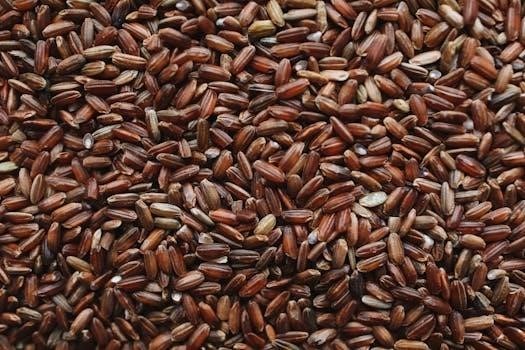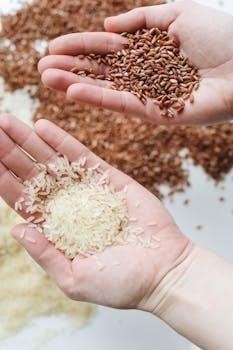The Autoimmune Protocol (AIP) diet is a structured elimination approach designed to manage autoimmune symptoms by minimizing inflammation. Rooted in Paleo principles, it excludes foods that trigger immune responses and emphasizes nutrient-dense options for healing. This diet is especially helpful for those with autoimmune conditions, such as inflammatory bowel diseases.
What is the Autoimmune Protocol (AIP) Diet?
The Autoimmune Protocol (AIP) diet is a specialized elimination diet that goes beyond the standard Paleo diet, specifically targeting individuals with autoimmune conditions. It aims to reduce inflammation and promote gut health by eliminating foods known to trigger immune responses. This approach involves removing items like grains, legumes, dairy, nightshades, nuts, seeds, and processed foods. The AIP diet focuses on consuming nutrient-dense foods to support the body’s healing process and restore balance to the gut microbiome. It is considered a rigorous dietary protocol designed to identify individual food sensitivities and manage symptoms associated with autoimmune diseases. The AIP diet is not a permanent solution, but a tool to identify trigger foods and tailor a long-term, sustainable diet.

AIP Diet Principles and Goals
The AIP diet’s core principles involve reducing inflammation and supporting gut health through a strategic elimination of inflammatory foods. The primary goal is to identify food triggers and manage autoimmune symptoms effectively.
Reducing Inflammation and Supporting Gut Health
The AIP diet is fundamentally designed to reduce systemic inflammation, a key driver in autoimmune diseases. This is achieved by eliminating foods known to provoke immune responses. Simultaneously, the diet focuses on nurturing gut health, recognizing the crucial role of the gut microbiome in immune regulation. By removing irritants and incorporating nutrient-dense foods, the AIP diet promotes a balanced gut environment, which is essential for optimal immune function. This dual approach aims to create a healing environment within the body, reducing the burden on the immune system and mitigating autoimmune symptoms. A healthy gut is better able to support an individual’s overall well-being and reduce inflammation.
Three Phases of the AIP Diet
The AIP diet unfolds in three distinct phases, each serving a specific purpose. The first is the elimination phase, which involves removing potential inflammatory triggers like grains, legumes, dairy, and processed foods. This aims to reduce immune activation and inflammation. The second phase is the reintroduction phase, during which foods are systematically reintroduced to evaluate their impact on symptoms. This helps identify specific triggers. Finally, the maintenance phase involves establishing a personalized, sustainable approach. This integrates safe, nutrient-dense foods while avoiding known inflammatory triggers. This phase is for long-term autoimmune control and symptom management and ensures a balanced, sustainable dietary approach.

Foods Allowed and Excluded on AIP
The AIP diet emphasizes nutrient-dense foods like meats, vegetables (excluding nightshades), and healthy fats, while excluding grains, legumes, dairy, processed foods, and nightshades to reduce inflammation.
Allowed Foods⁚ Nutrient-Dense Options
The Autoimmune Protocol diet focuses on a wide array of nutrient-rich foods that support healing and reduce inflammation. This includes high-quality animal proteins like grass-fed beef, chicken, turkey, and organ meats, which provide essential amino acids and vital nutrients. Wild-caught fish and seafood are also encouraged, offering omega-3 fatty acids crucial for reducing inflammation. A variety of vegetables, excluding nightshades, form a significant part of the diet, providing fiber, vitamins, and minerals. Fresh fruits are allowed in moderation, offering natural sweetness and antioxidants. Healthy fats from sources like coconut oil, olive oil, and avocado are essential for energy and cell function. Fermented foods, such as sauerkraut, help promote a healthy gut microbiome. Natural sweeteners like maple syrup and coconut milk can be used sparingly, ensuring the diet remains nutrient-dense and supportive of overall health.
Foods to Avoid⁚ Inflammatory Triggers
The AIP diet strictly eliminates foods that are known to trigger inflammation and exacerbate autoimmune symptoms. Grains, including wheat, rice, and oats, are completely removed due to their potential to irritate the gut lining. Legumes, such as beans, lentils, and peanuts, are also excluded because of their inflammatory compounds. Dairy products, including milk, cheese, and yogurt, are prohibited due to their casein and lactose content, which can cause digestive issues. Nightshade vegetables, like tomatoes, potatoes, and eggplants, are avoided because they contain compounds that can trigger inflammation in susceptible individuals. Processed foods, with their additives, preservatives, and artificial sweeteners like corn syrup, are strictly off-limits. Refined sugars, such as brown sugar, are also restricted. These eliminations are crucial to reducing the body’s inflammatory response and promoting healing from autoimmune conditions.

Benefits of Following an AIP Diet Plan
Following an AIP diet plan helps manage autoimmune symptoms by reducing inflammation. It also helps in identifying food triggers. The plan promotes overall gut health and well-being through dietary changes.
Managing Autoimmune Symptoms
The primary goal of the Autoimmune Protocol (AIP) diet is to alleviate the symptoms associated with autoimmune diseases by systematically reducing inflammation. By eliminating common triggers, such as grains, legumes, and processed foods, the AIP diet aims to calm the overactive immune system. This process can lead to noticeable improvements in various symptoms, including fatigue, joint pain, and digestive issues, which are often experienced by individuals with autoimmune conditions. The diet emphasizes nutrient-dense, anti-inflammatory foods, which further supports the body’s healing mechanisms. The elimination phase allows the body to rest and recover from the constant inflammatory response. This structured approach provides a path to symptom relief and enhances overall well-being by addressing the dietary factors that contribute to autoimmune flares. Through this, individuals can begin to experience a significant improvement in their quality of life.
Identifying Food Triggers
A crucial benefit of the Autoimmune Protocol (AIP) diet is its ability to help individuals pinpoint specific foods that trigger their autoimmune symptoms. The elimination phase removes common inflammatory culprits, and the reintroduction phase systematically introduces these foods back into the diet, one at a time. This structured approach allows individuals to carefully observe their body’s reactions and identify which foods are well-tolerated and which cause a return or worsening of symptoms. By tracking these reactions, individuals can create a personalized dietary plan that avoids their specific triggers. This level of customization enables long-term symptom management by eliminating the foods that cause immune dysregulation. The AIP diet provides a clear path to identifying food sensitivities, leading to a more targeted and effective approach to managing autoimmune conditions and promoting overall health.
Practical Implementation of AIP
Implementing the AIP diet involves careful meal planning, grocery list creation, and utilizing resources like AIP diet plan templates. These tools aid in navigating the diet’s phases effectively for success.
AIP Meal Planning and Grocery Lists
Effective AIP meal planning is crucial for success, requiring a structured approach to ensure adherence and variety. Begin by creating a weekly meal plan that incorporates allowed foods, such as grass-fed meats, wild-caught fish, and a wide array of vegetables, excluding nightshades. A well-organized grocery list is essential, categorizing items by food group to streamline shopping trips. Utilize online resources and AIP-specific cookbooks to find recipes that align with your dietary needs. When planning, consider batch cooking to save time and ensure you have compliant meals readily available. Focus on incorporating nutrient-dense foods and vary your meals to prevent monotony. Remember to plan for snacks as well, using options such as fruits, coconut milk, or small portions of cooked meats. Review your meal plan and grocery list weekly, adjusting based on your preferences and any identified food sensitivities.
Using an AIP Diet Plan Template (PDF)
An AIP diet plan template, often available in PDF format, offers a structured framework for implementing the Autoimmune Protocol. These templates typically include sections for meal planning, grocery lists, and tracking symptoms, making it easier to follow the diet effectively. To use a template, start by downloading and printing it, or if it’s an interactive PDF, open it on your device. Begin by filling in the meal plan section with meals and snacks that adhere to AIP guidelines, focusing on nutrient-dense, anti-inflammatory foods. Next, create a corresponding grocery list based on your meal plan, categorizing items for efficient shopping. Use the template to log your meals and monitor how you feel after eating. Many templates also have space to note symptom changes, which is important during the elimination phase and reintroduction periods. Customize the template to meet your individual dietary needs and preferences, ensuring you’re using it as a guide for your specific AIP journey. This tool is invaluable for keeping your diet organized and consistent.

Timeline and Effectiveness of the AIP Diet
The AIP diet’s effectiveness varies, with most noticing improvements within 4-6 weeks of the elimination phase. Long-term results depend on adherence and identifying personal food triggers during the reintroduction phase.
How Long Does it Take to See Results?
The timeline for experiencing noticeable results on the Autoimmune Protocol (AIP) diet can vary from person to person. However, many individuals report seeing initial improvements in their symptoms within the first four to six weeks of strictly adhering to the elimination phase. This initial period focuses on removing potential inflammatory triggers, allowing the body to begin reducing overall inflammation levels. It’s crucial to remember that the AIP diet is not a quick fix and requires consistency and patience. While some may notice significant changes early on, others may take longer to feel the full benefits, depending on factors like the severity of their condition, their level of adherence to the diet, and individual responses. Long-term success depends greatly on diligently following the reintroduction phase to identify specific food triggers, and maintaining a personalized and sustainable dietary approach. Continued commitment and monitoring is very important to achieve consistent and lasting results.


